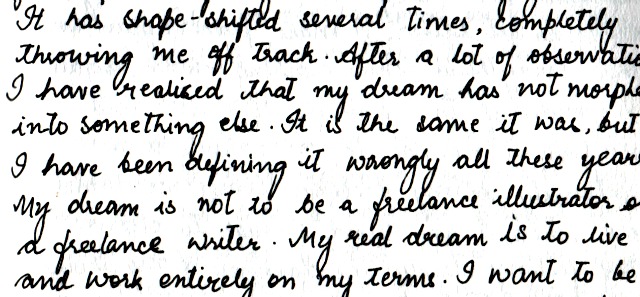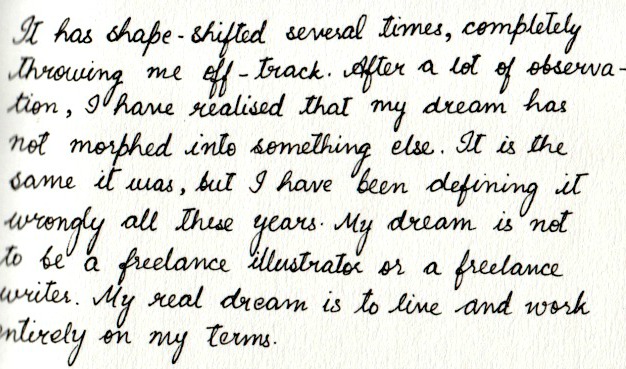by Akshata
All through school and college, somewhere in the gap between the final exam and the start of a new academic year, I forgot how to write properly. It was funny and maddening how just two months of almost writing-free vacations could make me forget what I had learned and practiced since I was in kindergarten.

I spent the first few days of my return to class trying to rediscover the ins and outs of my handwriting, and then tearing up the crisp sheets of new notebooks that had been uglified by my attempts to do so.
After I got acquainted with the computer and began to use it on a regular basis, this handwriting-related amnesia turned into a fixture in my daily life. Every time I picked up pen and paper, I ended up frustrated that my handwriting kept changing, yet staying somewhat similar, from one snippet of writing to the next. One minute is was too sharp, the next it was too curved. One minute it was too upright, the next it was too slanted. It was my handwriting, but it wasn’t my handwriting.
It was as if a hundred students were imitating in their notebooks what their teacher had written on the blackboard. None of them got it completely wrong, but none of them got it completely right either.
I made multiple attempts to regain my natural style of writing. In the past few months, I have succeeded at it. Now my writing is fairly effortless, as it was when I was drowning in assignments in school and college. Even on the odd occasion I forget how to write properly, I get back on track with ease, simply by bringing my focus back to the mechanics of writing well. I have outlined those below to help anyone wanting to improve their penmanship, no matter how bad a state it is in right now.
Write from your upper arm, not from your wrist
When I took up a drawing class a few years ago, the instructor made me draw only circles and lines for three days straight. Concentric circles, overlapping circles, tall ovals, squishy ovals, straight lines, curved lines, zigzag lines, dark lines, light lines, wavy lines, grids, reverse lines, and every other kind that you can imagine. It was mind numbing, made more so by my impatience to get to the “real drawing”.
As I understood later, that line-and-circle exercise is what brings the fluidity to an artist’s brush or pencil strokes. It does that by ensuring that the strokes on canvas or paper arise not from the forced, constricted movement of the wrist, but from the free-flowing movement of the entire arm. Imitate this movement and you can see the difference for yourself. In the first case, only your thumb and forefinger move up and down, clutching the pen or pencil in a death grip. In the second case, the side of your palm makes smooth designs on the surface of the paper, led by the movement of your elbow, which in turn begins at your shoulder.
Replicating that arm movement can do wonders for your handwriting, but it is not easy, because you never know if you have got it right. That’s why you need the next step.
Tilt the paper
Keep your notebook angled away from you when you write. This automatically makes your elbow move outward and away from your body, which in turn relaxes your arm. Without realizing it, you loosen your hold on the pen/pencil and engage your entire arm, both of which are key to free and fluid writing.
As JD Bentley wrote in this post:
Shapes are better when they just happen, not when you try hard to make them happen.
Take your time
Write as if you have all the time in the world, and let the tip of your pen merely whisper over the surface of the paper. You’ll begin to notice that your pen strokes are becoming elongated, stylish, and curvier, all of which make for beautiful, legible handwriting. Use a fountain pen or a gel pen, and the results are even better.
If you slow down your writing at least till you have had sufficient practice at writing well, your arm internalizes that easy movement and makes you consistent at recreating it. As time elapses, it does not matter even if you write faster. The speed will not have too much of a negative impact on the aesthetics of your writing.
Memorize & Practice
Overall, my handwriting looks consistent, but when I look closely, I notice that I mix up letter styles too much. Sometimes I dot the is with a tiny speck and sometimes with a hollow circle. Either I cross the ts too high or too low. Sometimes I write capital F facing left and at other times, facing right.
I find myself pausing frequently in the midst of writing a letter, because I can’t remember how I usually write it. If this is your dilemma too, create a letter set for reference. Write each letter with care and ensure that it is closest to your ideal. Practice it till you can write it in your sleep. The accidental inconsistencies, even the minute ones, can detract from the beauty of your penmanship. The deliberate ones can add to it the charm of a signature style.

Most importantly…
Own your handwriting no matter which phase of improvement it is going through. Instead of trying to capture the elusive beauty and essence of someone else’s handwriting, focus on adding some flair to your own.
Akshata is a writer, doodler, and people watcher doing her best to find the sacred in the ordinary. In addition to writing about her slow living experiments at akshata.co, she writes for the popular technology blog MakeUseOf.

2 Comments
Comments are closed.